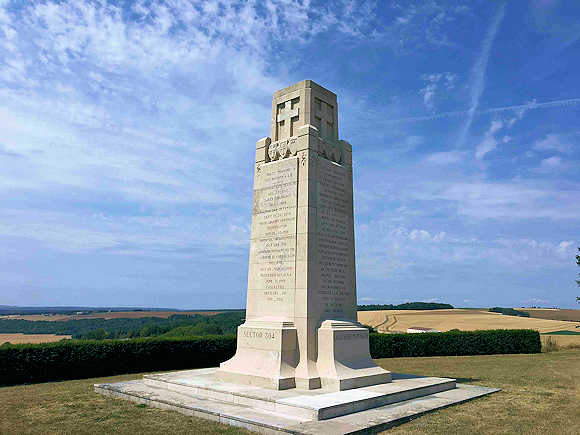 |
| Cornwilly Hill Today (U.S. Memorial Faintly Visible on Left Ridge) |
Following the fall of Montfaucon, the task of directing German artillery fire fell to observers and spotters on Hill 378 located in the ridges lining the east bank of the Meuse River, high above the village of Sivry-sur-Meuse. The observation post on La Borne de Cornouiller—or "Cornwilly Hill," as the Doughboys called Hill 378—could direct fire to any location of the 24-mile-wide Meuse-Argonne Front. It was especially a hindrance to the U.S. III Corps that had begun crossing the Meuse on 1 November with the mission of capturing the Meuse river's east heights.
 |
| Position of Cornwilly Hill Prior to Arrival of 79th Division |
General Pershing insisted on its capture and called on the 79th to carry out the task, supported by the U.S. units and the French 15 Colonial division on its flanks. The division commander, Major General Joseph Kuhn, called Cornwilly Hill "an obstacle of the most serious character," and the attack proved extremely difficult. The hill was riven by deep ravines lined with trenches, bolstered by reinforced bunkers and peppered by machine guns. Beginning on 3 November, the Doughboys of the 79th Division mounted successive assaults on the hill, finally forcing the defenders to abandon Cornwilly Hill on 6 November 1918.
 |
| Position of Cornwilly Hill after Deployment of 79th Division |
The division, particularly the 316th Infantry, had taken some of their heaviest casualties of the war. The division continued attacking eastward through the Meuse Heights until the Armistice. Its final list of fatalities would include Sgt. Henry Gunther of Baltimore, MD, the last man killed in action during the war.
 |
| Wounded Men of the 316th Infantry |
Today, a memorial to the men of the 316th Infantry of the division, who captured Cornwilly Hill that day, sits on the site overlooking the entire Meuse-Argonne battlefield. It has an interesting history, itself. Not approved by either General Pershing or the French government, the regiment's veterans found a way around the red tape to get it built.
Sources: American War Memorials Overseas; 79th Division History; 316th Regimental History; ABMC


The 79th Division only sent out strong patrols on 3 November, but they nevertheless advanced the division line forward 500 yards in severe fighting. The 79th Division then reached a line near the crest after further desperate fighting on 4 and 5 November. This success and the progress made by other divisions to the north forced the German troops to withdraw from the heights in this vicinity. A deep advance was made on 7 November and the next day the 79th Division moved rapidly forward to the eastern edge of these heights. Substantial gains were made thereafter until the Armistice on 11 November. I would say that it is erroneous to assume that the Germans completely abandoned Hill 378 on 6 November. See American Armies and Battlefields in Europe, American Battle Monuments Commission, Washington, D.C.: United States Government Printing Office, 1938, pp. 269-270.
ReplyDeleteMy grandfather fought for the germans at Cornwilly hill.
ReplyDeleteGreat Uncle was in 79th Division
DeleteLink to doc mentioned above
ReplyDeletehttps://history.army.mil/html/books/023/23-24/CMH_Pub_23-24.pdf
My great-uncle, John O'Connor, was in the 316th Regiment. Here's a history of the regiment: https://babel.hathitrust.org/cgi/pt?id=hvd.hn4ssn&seq=77&format=plaintext
ReplyDeleteMy great uncle Leo P. Naumann, from Dubuque County, Iowa, fought with the 316th and was found wounded on the field of battle on November 3. He died of his wounds in a field hospital on November 14, three days after Armistice.
ReplyDelete